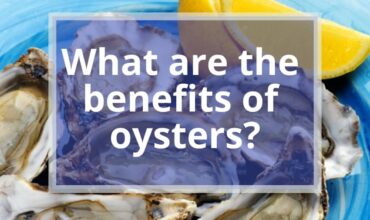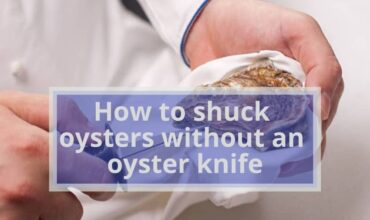It is slightly different when you look for an oyster shucking knife. Why? Oyster knives are available in various types, and the specifications of each type are related to a specific kind of oyster. In other words, oyster shucker is manufactured to fit oysters’ various features of each area and are named according to where the oysters were found.
That is why knife type is the main criteria you should look at to make a good choice. After choosing the right type, you will know more about the blade’s durability and features, handle structure, grip comfort, and versatility.
In general, the material of the blade must be strong enough to serve its purpose efficiently. Most oyster knives are made from stainless steel or carbon steel. But an anti-corrosion blade (stainless steel blade) is better as the saltwater of oysters could damage the blade. Around a 3-inches blade is the best length; try not to use longer blades as this will make it weaker and could wrap when you push the knife to open the shell.
For the shape of the blade, narrow or wide blades, both go well with oysters’ different types and sizes. Shucking oysters could take a long time due to the number of oysters you need to shuck. That is why you need a lightweight, firm handle with a comfortable grip to make the shucking task easier. Read on to know how to choose an oyster knife, oyster knives’ main types, and the main features of each type.
Oyster Knife Main Types
- Boston Type
- Galveston
- New Haven
- Providence
Boston Type For shucking oysters from the side instead of the hinges
This built well, solid, and versatile oyster shucker knife is available in two sizes. A 3-inch blade is perfect for shucking small to medium-sized oysters. While the 4-inch blade suites large Atlantic and pacific oysters.
Knife Structure
This knife is built well and feels solid in your hand.
Blade Features
- A robust and durable blade made of high carbon steel is suitable for different tasks.
- The long blade ends with a rounded tip. You’ll be able to cut through anything without fear of cutting yourself
- Slightly convex and gradually narrows towards the top.
- Not a very sharp blade.
Handle structure
- Boston’s rounded or long pear-shaped non-slip handle starts with a slight bump that enhances thumb stability and rests. Then the narrow middle part of the handle gives you a comfortable grip and rest for your four fingers. Another bump part for enhancing your hand’s palm comfort and stability comes at the end.
- The lightweight handle is manufactured from polypropylene.
Also read, How to shuck oysters without an oyster knife
Galveston Type , A commercial Choice
- Galveston pattern with a Sani-Safe handle
- High Carbon, High Alloy, Stain free DEXSTEEL
- This knife is NSF certified
- Care: Hand wash and dry after use
- Made in USA
Thie type is perfect for large Atlantic oysters and medium-sized European oysters.
Knife Structure
Same as the Boston type, you will feel this type’s strength in your hand.
Blade Features
- The blade of the Galveston type is long, wide, and flat with a very slight curvature.
- The knife’s strong blade narrows to a rounded point tip. It is sharp enough to cut the abducens muscle of any shellfish.
You may also like to read our buying guide for best oyster shucking kitchen tools.
Handle structure
The handle of the Galveston type is pear-shaped with the same structure as the Boston type.
New Haven Type, American favored
This knife’s classic design is perfect for using the traditional hinge method to shuck your oysters. It will give you the strength you need to shuck oysters easily. It is ideal for small to medium-sized Atlantic, Pacific, Kumamoto, and Olympia oysters.
Knife Structure
Same as the Boston type, you will feel this type’s strength in your hand.
Blade Features
- The blade of the new haven style is short and wide.
- The knife’s high carbon steel blade ends with an upcurved pointed tip.
- While using the classic hinge method for shucking your oysters, it is essential to keep the blade’s tip away from oysters’ soft meat and not damage it; thus, this convex pointed tip is perfect for this purpose primarily if you will cater raw oysters on the half shell.
- You can also use this tip to clean oyster meat on the half shell.
Handle structure
- A comfortable and non-slip long pear-shaped handle gives you a perfect shucking grip.
- The new haven oyster knife handle is usually made from natural hardwood or polypropylene.
Read more , The Best 3 Oyster Grilling Pans And What To Consider
Providence Type
- Ship Weight: .17 lbs.
- Blade Length: 2.75″
- Blade Tip: Rounded
- Edge Type: Straight Edge
- Handle Material: Plastic
It goes well with oysters of different sizes, especially small to medium-sized ones, and It’s perfect when you use the hinge method for shucking oysters.
Blade Features
- The solid and durable blade made is made of high carbon steel.
- The blade of the Providence type is short, wide, and straight.
- The knife’s blade ends with a flat pointed tip.
- The blade’s flat edge is excellent for moving oysters from the shell.
Handle structure
A long pear-shaped handle that gives you a perfect shucking grip.
Oyster Knife extra features
Package Features
Some oyster knives are sold separately, whereas others come in sets. An oyster knife set comes with extra features like carrying cases, a cut-resistant glove, etc.
Dishwasher Safe or Hand Wash Only
The materials used to create the oyster knife determine if the blade needs only be cleaned by hand or dishwasher safe. If you’re not sure whether your knife is dishwasher safe, then you should probably try to hand-clean it. It just keeps them sharper for longer if you can spare some hand-washing time
FAQ’S about how to pick an oyster knife
What’s the best way to open oysters?
People usually use the hinge method when shucking oysters. They use the knife between the shells in the back while using finesse to cut the muscles holding the shells together.
The hinge method is used when working on a flat surface such as a tabletop. The front door method is used when holding an oyster shell steady while inserting a knife into the shell.
What is the Difference Between a Clam knife and Oyster Blade?
Clam blades are flat and come in many shapes and sizes. Some people use them to cut through thick shells, while others use them to open oysters.
Oyster knives are short and firm with sharp ends.
What is an oyster knife called?
A “stabber“: the “stabber,” or “stabbing knife,” has a narrow, flat blade and a pointy tip. The design is an East Coast classic and primarily associated with the Eastern oyster (the Pacific variety).
Should an oyster knife be sharp?
Oyster knives are not sharp on both edges but slightly sharp on the rounded point. Most kitchen knives are sharp on one side or the other. That is why you shouldn’t use a kitchen knife to open an oyster. It could be the end of your knife or your hands.
What do you call a person who shucks oysters?
Every Red Oyster, oyster shucker is an Oyster entertainer.
What makes a good oyster shucking knife?
It would be best if you carried an oyster knife in your pocket because they come in a variety of different shapes, sizes, and styles, so it’s always good to know how they feel in your hands. The grip should feel comfortable, while the blade should feel sturdy enough to cut through even the most challenging fresh oyster shell.









